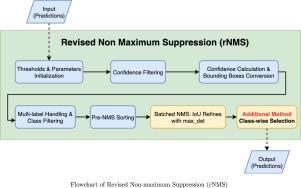Revised NMS-driven pipeline for heart valve regurgitation and Kawasaki disease coronary aneurysm localization
IF 6.3
2区 医学
Q1 BIOLOGY
引用次数: 0
Abstract
Object detection in echocardiography is still uncommon, yet precise localization of pediatric valvular regurgitation and Kawasaki-related coronary aneurysms is critical. We introduce two lightweight variants of non-maximum suppression, rNMS-P (used only at inference) and rNMS-TP (used during both training and inference), that improve YOLO v5 to v9 detectors without altering their backbones. The system combines horizontal boxes for valve jets with rotation-aware oriented boxes for coronary segments, applies anatomical constraints by keeping a single high-confidence box per class, and can relax this rule for well-represented lesions. On color and grayscale echocardiograms, rNMS-TP increased [email protected] from 79.7% to 80.5% for regurgitation and from 85.7% to 86.5% for Kawasaki disease, with gains up to 2.3% at the stricter [email protected]:.95 threshold; rNMS-P provided up to a 2.1% boost, all with negligible computational cost, offering a practical path toward explainable, operator-independent cardiac image assessment.

改良的nms驱动管道用于心脏瓣膜反流和川崎病冠状动脉瘤定位
超声心动图中的目标检测仍然不常见,但精确定位儿童瓣膜反流和川崎相关冠状动脉瘤是至关重要的。我们介绍了两种非最大抑制的轻量级变体,rNMS-P(仅用于推理)和rNMS-TP(在训练和推理期间使用),它们在不改变YOLO v5到v9探测器骨干的情况下改进了YOLO v5到v9探测器。该系统结合了用于瓣膜喷射的水平盒和用于冠状动脉节段的旋转感知定向盒,通过保持每个类别的单个高置信度盒来应用解剖学约束,并且可以放宽这一规则来代表良好的病变。在彩色和灰度超声心动图上,rNMS-TP在反流中从79.7%增加到80.5%,在川崎病中从85.7%增加到86.5%,在更严格的[email protected]中增加到2.3%。95阈值;rNMS-P提供了高达2.1%的提升,所有这些都可以忽略不计的计算成本,为可解释的、独立于操作员的心脏图像评估提供了一条实用的途径。
本文章由计算机程序翻译,如有差异,请以英文原文为准。
求助全文
约1分钟内获得全文
求助全文
来源期刊

Computers in biology and medicine
工程技术-工程:生物医学
CiteScore
11.70
自引率
10.40%
发文量
1086
审稿时长
74 days
期刊介绍:
Computers in Biology and Medicine is an international forum for sharing groundbreaking advancements in the use of computers in bioscience and medicine. This journal serves as a medium for communicating essential research, instruction, ideas, and information regarding the rapidly evolving field of computer applications in these domains. By encouraging the exchange of knowledge, we aim to facilitate progress and innovation in the utilization of computers in biology and medicine.
 求助内容:
求助内容: 应助结果提醒方式:
应助结果提醒方式:


